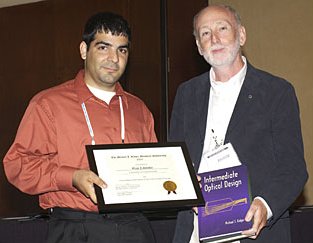| you are here:
Kidger Home
/
Michael Kidger Memorial Scholarship / Awardees / Winner 2005
Michael Kidger Memorial Scholarship:
2005 AWARDEE - OZAN CAKMAKCI
|
|
 Update 2010
Update 2010
Currently with Optical Research Associates, Pasadena, California, Ozan is a
Ph.D. graduate of the College of Optics and Photonics, CREOL, the University of
Central Florida where his thesis supervisor was Professor Jannick Rolland.
"After receiving the Kidger Scholarship award in 2005, I worked on designing and fabricating a dual-element head-worn display, which served as my introduction into applying free-form surfaces in optical design. Subsequently, I became interested in alternative surface descriptions and proposed radial-basis functions as a way to describe rotationally non-symmetric surfaces. As a result, a single mirror head-worn display solution with a radial basis function surface has been fabricated. My current work involves optical engineering for a wide range of applications."
|

Ozan (left) receives 2005 Award Certificate from David Williamson, Chairman Michael Kidger Memorial Scholarship Committee, at San Diego, California, 3 August 2005. Ozan also received a copy of each of Michael Kidger's books, Fundamental Optical Design and Intermediate Optical Design.
|
Award Year 2005
Ozan Cakmakci, a graduate research assistant at the College of Optics/CREOL, University of Central Florida, was selected as the 2005 Michael Kidger Memorial Scholarship awardee. Ozan's Supervisor is Dr Jannick Rolland, Associate Professor of Optics, ECE & Computer Science, "Optical Diagnostics and Applications Laboratory." The award was presented by David Williamson, Chairman of the Kidger Scholarship Committee, at SPIE's Optics and Photonics 2005 Symposium, San Diego, California, on 3 August 2005. The award was a cash award partially supported by Thales Optics Ltd (later to become Qioptiq Ltd), St Asaph, North Wales, U.K.
Ozan is interested in the optical design of mobile augmented reality displays that provide realistic overlays. To this end, Ozan is working on the design and development of a head-worn display that can support mutual occlusions. Mutual occlusion is an attribute of an
augmented reality display where real objects can occlude computer generated superimposed objects and computer generated superimposed objects can occlude real objects. In the current design, the system consists of an objective lens that images a scene onto a reflective
spatial light modulator. The scene is modulated and combined with computer generated images with an x-cube polarizing prism. The combined output is mapped back onto the scene with unit magnification and upright orientation with an eyepiece.
Deciding whether a virtual object is in front of or behind a real object requires depth information about the scene. Ozan and his advisor are exploring the use of 3D cameras
for real-time depth extraction.
|
|

